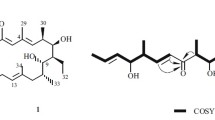Abstract
A mycelial extract ofTrichoderma reesei (P-12) was separated into four fractions by high performance liquid chromatography (HPLC). Out of these, two were found to exhibit antifungal activity when tested against plant pathogenic fungi. The level of antifungal compounds was higher in media containing glucose as the carbon source as compared to one containing cellulose. The synthesis of these antifungal compounds started after 3 days of inoculation at 30°C and continued upto 8 days. No further increase was recorded beyond this period.
Similar content being viewed by others
References
Backman P A and Kabana R R 1975 A system for the growth and delivery of biological control agents to the soil. Phytopathol. 65, 819–821.
Dennis C and Webster J 1971 Antagonistic properties of species groups of Trichoderma. I Production of non-volatile antibiotics. Trans. Br. Mycol. Soc. 57, 25–39.
Dennis C and Webster J 1971 Antagonistic properties of species groups of Trichoderma. II Production of volatile antibiotics. Trans. Br. Mycol. Soc. 57, 41–48.
Elad Y, Chat I and Katan J 1980Trichoderma harzianum a biocontrol agent effective againstSclerotium rolfsii andRhizotonia solani. Phytopathol. 70, 119–121.
Elad Y, Hadar Y, Hadar E, Chet I and Henis Y 1981 Biological control ofRihzoctonia solani byT. harzianum in carnation. Plant Diseases 65, 575–577.
Elad Y, Kalfon A and Chet J 1982 Control ofRhizoctonia solani in cotton by seed coating withTrichoderma spp. spores. Plant and Soil 66, 279–281.
Godtfredson W O and Vangedals S 1986 Trichodermin, a new sesquiterpene antibiotic. Acta Chem. Scandin. 19, 1088–1102.
Harman G E, Chet I and Baker R 1980Trichoderma hamatum effects on seed and seedling disease induced in radish and pea byPythium spp. orRhizoctonia solani. Phytopathol. 70, 1167–1172.
Lewis J A and Papavizas G C 1984 A new approach to stimulate population, proliferation ofTrichoderma spp. and other potential biocontrol fungi introduced into natural soils. Phytopathol. 74, 1240–1243.
Mercer P C and Kirk S A 1984 Biological treatment for the control of decay in tree wounds. I Laboratory tests. Ann. Appl. Biol. 104, 211–219.
Papavizas G C 1982 Introduction and augmentation of microbial antagonists for the control of soil borne plant pathogens.In Biological Control in crop Production. Ed. G C Papavizas. pp 305–322. BARC Symp 5. Allanheld & Co. Totowa NJ.
Reese E T, Siu R G H and Levinson H S 1950 The biological degradation of cellulose derivatives and its relationship to the mechanism of cellulose hydrolysis. J. Bacteriol. 59, 485–497.
Sivan A, Elad Y and Chet I 1984 Biological control effect of a new isolate oftrichoderma harzianum onPythium aphanidermatum. Phytopathol 74, 498–501.
Author information
Authors and Affiliations
Rights and permissions
About this article
Cite this article
Watts, R., Dahiya, J., Chaudhary, K. et al. Isolation and characterization of a new antifungal metabolite ofTrichoderma reesei . Plant Soil 107, 81–84 (1988). https://doi.org/10.1007/BF02371547
Received:
Revised:
Issue Date:
DOI: https://doi.org/10.1007/BF02371547




